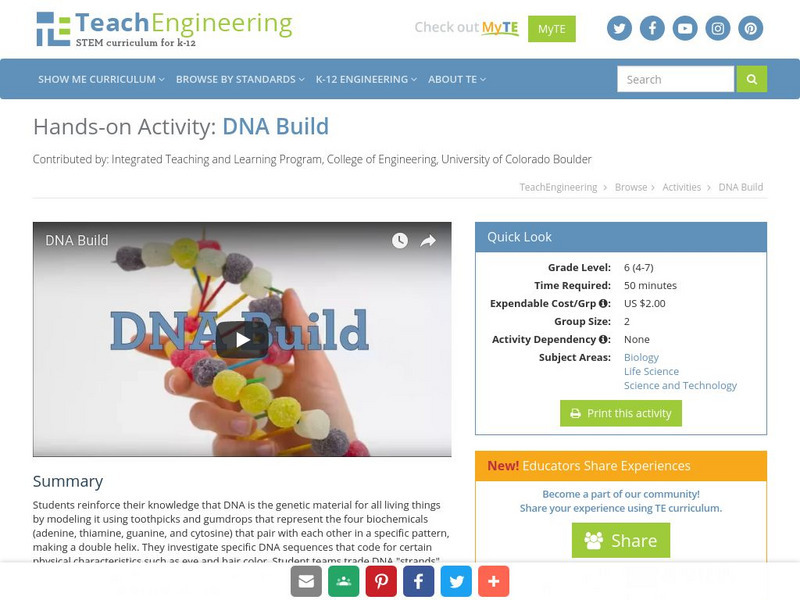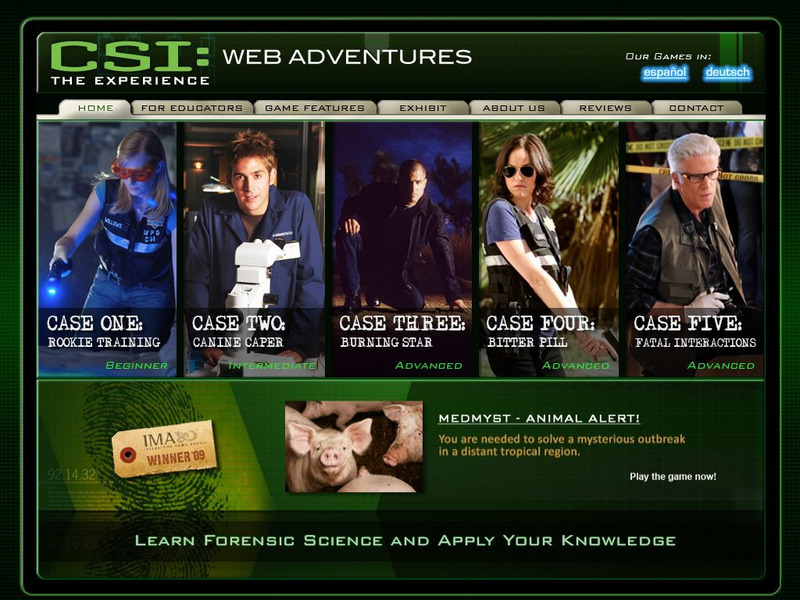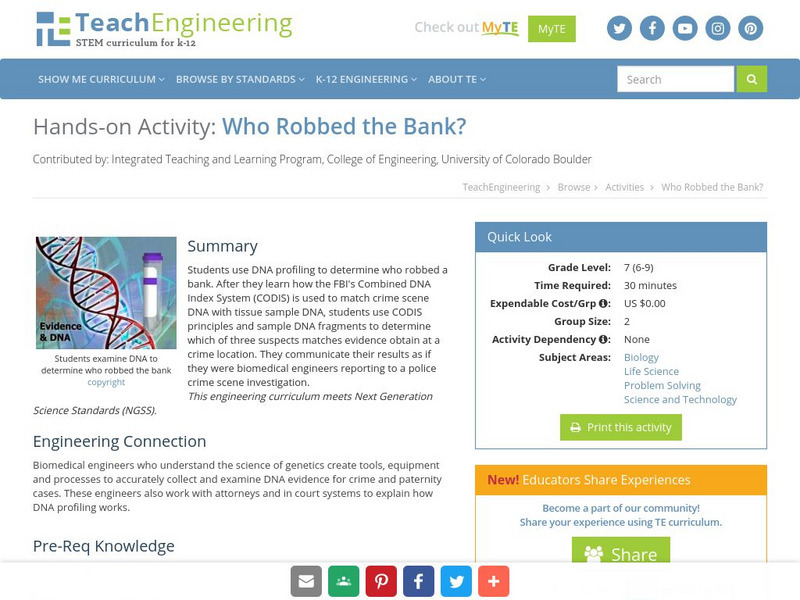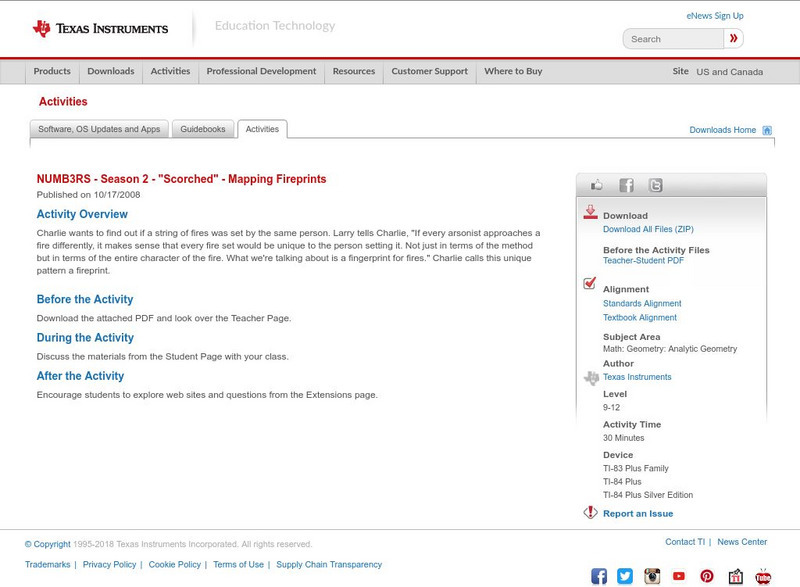Hi, what do you want to do?
Other
Crime Scene Investigator: Evidence Collection Guidelines
A list of specific types of evidence that could be collected from a crime scene. Links to methods for collecting the following kinds of evidence: blood stains, seminal stains, hair, fibers and threads, glass, paint, flammable liquids,...
John Wiley & Sons
Concepts in Biochemistry: Structure Tutorials
Learners explore the Biochemistry topic of deoxyribose nucleic acid (DNA). Topics examined are DNA replication, cloning, and fingerprinting. The resource consists of articles and animations and culminating questions.
Seeker
Seeker: Week of 3 10 14: Fingerprinting Clouds
Scientist have recently discovered that clouds possess far more unique traits than just their shapes. Read about the scientific discovery that at least some clouds contain biological particles that can be analyzed to show where the cloud...
Other
Find Biometrics, Global Identity Management
This site is geared more toward a consumer than a student, but it does list, describe, and in some cases compare each of the primary identification methods (fingerprints, iris recognition, voice, etc).
Cold Spring Harbor Laboratory
Dna Interactive: Applications
Examples of using DNA for forensic purposes is discussed here, as well as uses to unravel historical puzzles, trace the history of a species and answer health problems.
National Health Museum
Access Excellence: Use of Dna in Identification
At this site from Access Excellence, you can read a transcript from a lecture at the University of California, San Francisco by a biology professor discussing the use of DNA in criminal identification.
Oak Ridge National Laboratory
Oak Ridge National Laboratory: Dna Forensics
A concise explanation of the use of DNA technologies in forensic identification from the Oak Ridge National Laboratory. Additional valuable resources are provided.
PBS
Pbs Teachers: Stellar Fingerprints: The Spectra of Stars
Identify the composition of stars by applying the ideas of quantum theory. Investigate the field of spectroscopy, and examine the spectra of stars to locate the emission and absorption lines of hydrogen.
Other
Ibm: Biometrics
This site from IBM provides a simple introduction to the field of biometrics and includes descriptions with examples for several personal identification and recognition systems (e.g., fingerprints, hand geometry).
TeachEngineering
Teach Engineering: Dna Build
Students reinforce their knowledge that DNA is the genetic material for all living things by modeling it using toothpicks and gumdrops that represent the four biochemicals (adenine, thiamine, guanine, and cytosine) that pair with each...
Yad Vashem, The World Holocaust Remembrance Center
Yad Vashem: The Auschwitz Album
An online exhibit of surviving visual evidence of what occurred at Auschwitz-Birkenau. Photos were taken by two SS men whose task was to take ID photos and fingerprints of the inmates.
The Franklin Institute
Inquiry Almanack: Bio Point
Discover from a student's point of view what a "DNA fingerprint," is and how it is extracted.
Curated OER
Ny Times: Biometrics to Track Who Crosses Borders
Discusses the challenges the U.S. government faces in using biometric data, such as scanned fingerprints and facial features, to track foreign visitors in an effort to control illegal immigration and terrorist activity. Click on link for...
Curated OER
Ny Times: Biometrics to Track Who Crosses Borders
Discusses the challenges the U.S. government faces in using biometric data, such as scanned fingerprints and facial features, to track foreign visitors in an effort to control illegal immigration and terrorist activity. Click on link for...
Language Guide
Language Guide: Los Trabajos
These interactive pictures focus on the vocabulary for common jobs. Pop-ups of the correct spelling appear, along with the audio of the correct Spanish pronunciation when the mouse is moved over each illustration.
Rice University
Rice University: Web Adventures: Csi: The Experience
Based on the CSI television show, this series of four role-playing games helps students learn the scientific method and try their hand at solving crimes. Discover if you have what it takes to be a forensic scientist.
TeachEngineering
Teach Engineering: Who Robbed the Bank?
Students use DNA profiling to determine who robbed a bank. After they learn how the FBI's Combined DNA Index System (CODIS) is used to match crime scene DNA with tissue sample DNA, students use CODIS principles and sample DNA fragments...
Web Elements
Web Elements Periodic Table: Osmium
This WebElements site offers lots of fundamental information on osmium, Bohr diagrams and details on its purification.
Corrosion Source
Corrosion Source: Osmium
This resource presents basic data, along with good information on the history, sources, properties and uses of osmium.
Texas Instruments
Texas Instruments: Numb3 Rs: Mapping Fireprints
Based off of the hit television show NUMB3RS, this diverse lesson has students perform linear regression analysis (to compare two fire variables), check three-dimensional points using a planar equation, and evaluate points to determine...
Other
Crime Scene Investigator: Searching and Examining a Major Case Crime Scene
An engrossing explanation of the appropriate behavior needed at a major crime scene. What should be done with the body? How is photography handled? What about fingerprinting? How are curious onlookers dealt with? The answers to the...
OceanView Publishing
Alcatraz History: George "Machine Gun" Kelly
Biographical information about the infamous gangster, George "Machine Gun" Kelly. Includes photographs and images of an original fingerprint card and prison transfer paper.
CommonLit
Common Lit: Biometrics: New Ids That Are Uniquely You by by Sharon Oosthoek
Police and law enforcement have historically used fingerprints to identify suspects and prosecute criminals. But now, using new technology and the science of biometrics, scientists have developed a different, and potentially more...
Alabama Learning Exchange
Alex: Taxonomy: The Importance of Classifying
This is a technology-based, hands-on Biology lesson used to introduce the topic of Taxonomy and the importance of classifying. Students will listen to a podcast about classifying every living thing on Earth. Students will then give some...
Other popular searches
- Dna Fingerprinting
- Dna Fingerprint
- Types of Fingerprints
- Analyzing Fingerprints
- Forensic Science Fingerprint
- Fingerprint Art
- Dna Fingerprinting Crime
- Fingerprint Patterns
- Crime Scenarios Fingerprint
- Dna Fingerprinting Lab
- Fingerprint Analysis
- Malcolm X Fingerprints

















